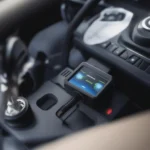Finding the right OBD2 scanner for your BMW E36 can feel like navigating a maze. With so many options available, it’s easy to get lost in technical jargon and conflicting information. Whether you’re a seasoned mechanic or a DIY enthusiast, you need a reliable scanner that can accurately diagnose and troubleshoot issues in your beloved E36. This guide will provide you with all the information you need to choose the perfect BMW E36 OBD2 scanner and use it effectively.
Understanding Your BMW E36 and OBD2 Technology
Before we delve into the specifics of OBD2 scanners, it’s crucial to understand the basics of OBD2 technology and how it applies to your BMW E36. OBD2, short for On-Board Diagnostics, is a standardized system that allows you to access your car’s computer and retrieve diagnostic information. It acts as a bridge between your car’s brain and a scanner, providing valuable insights into its health and performance.
The BMW E36, produced from 1991 to 1999, straddles the line between pre-OBD2 and OBD2 compliance. While some early models might have a 16-pin OBD2 port, they may not fully support all OBD2 protocols. On the other hand, later E36 models, typically from 1996 onwards, are more likely to be fully OBD2 compliant.
Choosing the Right OBD2 Scanner for Your BMW E36
Now that you understand the basics, let’s explore the different types of OBD2 scanners available and their suitability for your E36:
1. Basic Code Readers: These entry-level scanners are budget-friendly and can read and clear basic engine fault codes. However, they might not provide access to all systems or offer advanced features.
2. Bluetooth or Wi-Fi Scanners: These scanners connect to your smartphone or tablet via Bluetooth or Wi-Fi, allowing you to view real-time data, log trips, and access a wider range of diagnostic functions.
3. Professional-Grade Scanners: These high-end scanners offer comprehensive diagnostic capabilities, including advanced coding and programming functions. They are typically used by professional mechanics and serious DIY enthusiasts.
4. BMW-Specific Scanners: These scanners are designed explicitly for BMW vehicles and can access manufacturer-specific codes and data not available through generic scanners.
Key Features to Consider
When choosing an OBD2 scanner for your BMW E36, consider the following factors:
- OBD2 Protocol Compatibility: Ensure the scanner supports all relevant OBD2 protocols, including ISO 9141-2 and KWP 2000, commonly found in E36 models.
- System Coverage: Determine which systems the scanner can access, such as engine, transmission, ABS, airbags, and more.
- Live Data Streaming: The ability to view real-time sensor data can be invaluable for diagnosing intermittent issues and monitoring engine performance.
- Coding and Programming: If you plan on making modifications or customizations to your E36, consider a scanner that offers coding and programming capabilities.
- User Interface and Software: Choose a scanner with a user-friendly interface and intuitive software that provides clear and concise information.
Using Your OBD2 Scanner: A Step-by-Step Guide
Once you’ve chosen the perfect scanner, using it is relatively straightforward:
- Locate the OBD2 Port: The OBD2 port in your E36 is typically located under the dashboard on the driver’s side.
- Connect the Scanner: Turn the ignition to the “on” position (do not start the engine) and connect the scanner to the OBD2 port.
- Turn on the Scanner: Power on the scanner and wait for it to establish communication with your car’s computer.
- Read and Clear Codes: Select the “Read Codes” function to retrieve any stored fault codes. Once you’ve addressed the underlying issues, use the “Clear Codes” function to erase the codes.
- View Live Data: Access the “Live Data” section to monitor real-time sensor data, such as engine RPM, coolant temperature, and oxygen sensor readings.
- Perform Advanced Functions: Depending on your scanner’s capabilities, you can perform additional functions like coding, programming, and adaptation.
Conclusion: Empowering Yourself with the Right OBD2 Scanner
Investing in a quality OBD2 scanner for your BMW E36 is an investment in your peace of mind. It provides you with the tools and knowledge to diagnose and troubleshoot issues, saving you time, money, and potential headaches down the road. By understanding the different types of scanners, their features, and how to use them effectively, you can confidently take control of your E36’s maintenance and ensure it continues to deliver the driving experience it was meant for.
FAQ
-
Can I use any OBD2 scanner on my BMW E36?
While any generic OBD2 scanner might work with later E36 models, it’s recommended to use a scanner that supports BMW-specific protocols for optimal compatibility. -
What does the “Check Engine” light mean?
The “Check Engine” light illuminates when your car’s computer detects a problem with the engine or emission control system. Using an OBD2 scanner can help you pinpoint the exact issue. -
Do I need to disconnect the battery before using an OBD2 scanner?
It’s generally not necessary to disconnect the battery before using an OBD2 scanner. However, always refer to your scanner’s manual for specific instructions. -
Can an OBD2 scanner fix problems with my car?
An OBD2 scanner is a diagnostic tool, not a repair tool. It helps you identify problems but doesn’t fix them. -
How often should I scan my BMW E36 for codes?
It’s a good practice to scan your car for codes at least once a month or whenever you suspect a problem.
For any further assistance or inquiries, feel free to contact us via WhatsApp: +1(641)206-8880 or Email: [email protected]. Our dedicated customer support team is available 24/7 to help you.


